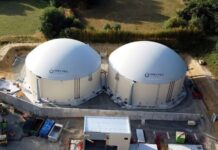The global sustainable aviation fuel market size is expected to grow USD 40.87 billion by 2034 and is reflecting a CAGR of 36.88% over the forecast period 2025 to 2034.
The growing demand for sustainable fuel in the aviation sector is driving the global need for sustainable aviation fuel (SAF). The adoption of SAF plays a significant role in reducing CO2 emissions. Governments worldwide are increasingly promoting sustainable development across various industries, which is expected to further accelerate the use of sustainable fuels in the coming years. An increase in investment in renewable energy, coupled with the implementation of stricter energy regulations, is anticipated to support the growth of the global SAF market. Leading SAF companies are shifting from crude oil processing to renewable fuels to expand their revenue streams and investing in carbon-neutral jet fuels to capture a larger market share.
Sustainable Aviation Fuel (SAF) is a renewable or waste-derived fuel that meets sustainability standards. It can be produced from various sustainable resources such as agricultural and forestry waste, cooking oils, carbon captured from the atmosphere, and green hydrogen. SAF can be mixed with traditional jet fuel to reduce emissions and is a “drop-in” fuel, meaning it can be used without requiring changes to aircraft or infrastructure. High-quality SAF plays a crucial role in cutting carbon dioxide emissions, with its emissions throughout production, distribution, transportation, and combustion being about 75% lower than those of fossil-based jet fuels. The potential for oil & gas refineries to integrate SAF technologies is vast, as SAF reduces harmful particulate and sulfur emissions by up to 90% and 100%, respectively.
Climate Change Concerns Driving the Demand for SAF
Climate change is one of the most pressing global challenges, requiring collective efforts across governments, societies, and industries to address it. Aviation, along with sectors like cement, steel, plastics, trucking, and shipping, contributes to approximately 30% of global annual carbon emissions. The rise in aviation emissions is linked to the increase in air travel. Projections suggest that air passenger journeys could exceed 10 billion by 2050, and the aviation sector is expected to return to its pre-COVID share of about 3% of total global greenhouse gas (GHG) emissions. Under a “business as usual” scenario, emissions could reach 21.2 gigatons of CO2 from 2021 to 2050.
Governments worldwide are adopting sustainable fuels and carbon capture technologies to reduce CO2 emissions, and the growing adoption of SAF is expected to help mitigate aviation sector emissions. SAF could reduce emissions by approximately 65%, helping the aviation industry reach its net-zero emissions target by 2050. The use of sustainable jet fuel is projected to increase in the 2030s as global policies support SAF and it becomes more competitive with fossil kerosene.
Expansion of SAF Deployment
Aviation companies are committed to reducing their net CO2 emissions by 2050. In October 2021, IATA member airlines pledged to achieve net-zero carbon emissions by 2050 during the 77th IATA Annual General Meeting in Boston. This commitment aligns the air transport sector with the Paris Agreement’s goal of limiting global warming to 1.5°C. Several countries are introducing energy regulations aimed at achieving net-zero emissions by 2050. However, the aviation sector is considered one of the most challenging to decarbonize, making SAF adoption one of the largest opportunities to help meet and exceed the industry’s 2050 goals. The sector is expected to require around 450-500 million tons of renewable jet fuel annually by 2050 to meet these targets.
Strong government support to channel feedstocks toward aviation, rather than other transport sectors, is expected to help address challenges in scaling up SAF use. In 2020, SAF cost $1.10 per liter compared to $0.50 per liter for conventional jet fuel. However, conventional jet fuel prices are projected to rise in the coming years, while SAF prices are expected to decrease. Market players are also likely to invest in the research and development of diverse feedstocks, including non-food crops, waste sources, and power-to-liquid fuels derived from recycled or directly captured CO2.
The Surge in Biofuel Adoption
The global sustainable aviation fuel market is divided into biofuels, power-to-liquid, and gas-to-liquid fuel types. The biofuel segment held the largest market share of 95.7% in 2021 and is expected to maintain dominance throughout the forecast period. Biofuels are derived directly or indirectly from organic materials, such as plant materials and animal waste. These fuels can deliver similar performance to petroleum-based jet fuels with a significantly lower carbon footprint. They can be produced from crops, forestry, agricultural waste, fishery products, or municipal waste.
The Growing Demand for HEFA-SPK Technology
The global SAF market is classified based on technology, including HEFA-SPK, FT-SPK, HFS-SIP, ATJ-SPK, and power-to-liquid. The HEFA-SPK segment dominated the market in 2021, accounting for 95.3% of the market share. The HEFA-SPK process uses fatty feedstocks, such as vegetable oils and waste fats, which undergo an oxygenation reaction followed by hydrogen addition to break down the fatty compounds into hydrocarbons. These compounds are then refined into various liquid fuels, which can be blended up to 50% with conventional jet fuel.
Regional analysis of sustainable aviation fuel market
North America: Leading the SAF Market
The sustainable aviation fuel market in North America was valued at $0.82 billion in 2024 and is expected to grow to approximately $18.92 billion by 2034. This market is driven by robust government support, including federal mandates and incentives for SAF adoption. Trends include significant investments from airlines and fuel producers in SAF production facilities, partnerships for research and development, and pilot programs to test SAF blends. North America is also at the forefront of SAF infrastructure development and commercialization.
Europe’s SAF Market Trends
In Europe, the sustainable aviation fuel market is projected to grow from $0.44 billion in 2024 to $10.26 billion by 2034. The market is driven by stringent environmental regulations and ambitious climate targets. Trends in Europe include widespread adoption of SAF by airlines, extensive government subsidies and mandates for SAF use, and active participation in international SAF initiatives. European countries are also integrating SAF into broader sustainability strategies to achieve net-zero emissions.
Asia-Pacific’s Rapid Growth in the SAF Market
The sustainable aviation fuel market in the Asia-Pacific region is expected to grow from $0.40 billion in 2024 to $9.15 billion by 2034. This growth is driven by rising aviation traffic and increasing environmental concerns. Governments in the region are developing SAF policies and incentives, investing in SAF research, and implementing pilot projects to integrate SAF into existing aviation infrastructure. Additionally, there is a focus on developing local SAF production to meet the region’s expanding aviation demands.
LAMEA’s Emerging SAF Market
The sustainable aviation fuel market in LAMEA (Latin America, the Middle East, and Africa) is emerging, with varying levels of adoption and development across countries like Brazil and the UAE. Key trends include early-stage SAF projects and collaborations, growing interest in sustainable aviation as part of broader energy transitions, and efforts to attract investment in SAF infrastructure. The region is focused on overcoming logistical challenges and building local SAF production capabilities to support regional aviation needs.
Get more insight@ https://www.cervicornconsulting.com/sample/2321








![SMART ENERGY WEEK [September] 2025 to Lead Global Renewable Energy Advancements SMART ENERGY WEEK](https://timestech.in/wp-content/uploads/2025/07/Untitled-design-2025-07-31T112230.406-218x150.jpg)








